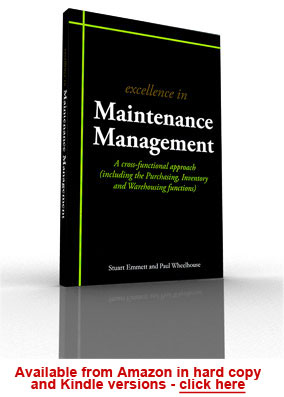This book covers how to evaluate current procedures, make changes to methods that will improve running times and service intervals, whilst achieving reductions in costs and inventory holding.
How to understand and implement all of the essential tools for efficient and effective maintenance are covered. There is also a framework for continuous improvement, along with descriptions of best in class practices and case studies.

Look inside book
Forewords
Stuart and Paul's book provides a comprehensive manual for anyone wishing to know more about the principles of effective Maintenance Management. Their book is clear, concise and tells you everything you need to know to become a competent practitioner.
I have known both Stuart and Paul for many years and not only are they both highly competent professionals, but they are also dedicated and commendable training consultants. Parts 1 to 3 of this book provide a thorough guide to maintenance and asset management.
Parts 4 to 6 build and expand upon this knowledge, broadening the scope to include discussions of the purchasing, inventory and warehousing functions. These are essential in the whole process of excellence in maintenance management, but can often be overlooked in other, purely technically-based, works. The final part pulls all of the aspects together to deliver practical and highly relevant advice upon how all of these skills and this knowledge can be utilised to optimise the management of plant and machinery for reliable operation and increased productivity.
Professor Andrew Ball PhD (Professor of Diagnostic Engineering and Pro-Vice-Chancellor for Research and Enterprise, University of Huddersfield, UK).
Having worked with Paul Wheelhouse (a co-author of this book) on a number of projects, in several parts of the world, I feel I am qualified to write this foreword from the point of view of, not only knowing the theory but seeing it practically applied.
The book is a comprehensive and jargon free guide, aimed at helping those responsible for managing assets, to achieve the seemingly mutually exclusive objectives of improving reliability and up-time, whilst spending less on spare parts and maintenance. Its contents are relevant to a broad range of production environments including: batch and continuous process operations and utilities.
One of the key successes of the book is that it makes the clear case for understanding the need to take asset management and maintenance out of the silo to which it is so often confined and to demonstrate its ability to add value rather than being tolerated as a necessary cost.
It defines a methodology for establishing a future vision for the organisation, evaluating its current performance and designing the roadmap to bridge the gap between the two. The contents also provide practical analytical and evaluation techniques illustrated with case studies. It additionally stresses, the often forgotten, softer issues, associated with people engagement and communication and the need to get the “whole organisation” on board with the change and why it is necessary.
As an engineer of more than 30 years experience in operations and maintenance, I recommend this book to you as reference that can both add real value to your business and enhance the perception of our profession.
Tony Hemming, 32 years operational experience in the Industrial Gases industry and currently responsible, globally, for reliability, maintenance and process safety
In the modern world, sub optimum maintenance management should not be tolerated. It costs businesses millions of pounds each year. Excellence in Maintenance Management addresses this issue and offers extremely useful tools, techniques and case studies. It demonstrates that a cross-functional approach is absolutely essential and that a properly structured continuous improvement process is vital for maintaining a competitive advantage. As a former student of Paul Wheelhouse, an Asset Manager and 2010 UK National Training Award Winner I can assure any reader that the methodologies detailed in this book, will never be far from hand.
Martin Hiorns, Area Engineer & TPM Facilitator, Warwick Chemicals
Within a business the phrase "operation is king" can be applied to either the production or delivery of a product and it is in this context that I regard maintenance and asset management as being a service to the operation. Effective maintenance of plant and equipment is therefore a key element in the delivery of a world-class service or a cost effective product, it complements the overall business strategy. An effective business must manage the investment on assets and maintenance in a manner that adds value and contributes to the overall objectives of the business. This book will help you understand and implement all the essential tools required to deliver this level of efficient and effective management.
Ged Conway, Director, Worldwide Engineering Company
Abstracts & Papers
 Benchmarking Maintenance & Asset Management for Performance Improvement by Paul Wheelhouse
Benchmarking Maintenance & Asset Management for Performance Improvement by Paul Wheelhouse
The value which maintenance and asset management provides an organization can be difficult to
measure. Benchmarking helps to assess this value and the best practices it discovers help to
improve performance. Best practices are reviewed from a range of different industries and six are
described which can be used to review cost-effectiveness.
Download pdf
 EFNMS 2012 Belgrade, Serbia: paper by Shimona Shodipo
EFNMS 2012 Belgrade, Serbia: paper by Shimona Shodipo
With the economic downturn and the inevitable cost cutting challenges that have been launched in order to make savings, maintenance and by extension asset management may seem to be the easy target. However, a penny saved now may result in many pounds being spent in the not too distant future to deal with the consequences of decisions not properly thought out.
Download pdf
 Maintenance Engineering Journal 2013: Paper by Paul Wheelhouse on KPIs
Maintenance Engineering Journal 2013: Paper by Paul Wheelhouse on KPIs
Key performance indicators are an essential part of any performance management system. Technical, behavioural and psychological aspects need to be covered. Measures must be SMART. Actions are only needed when significant changes occur. A useful checklist guide for key performance indicator essentials is included.
Read article online









